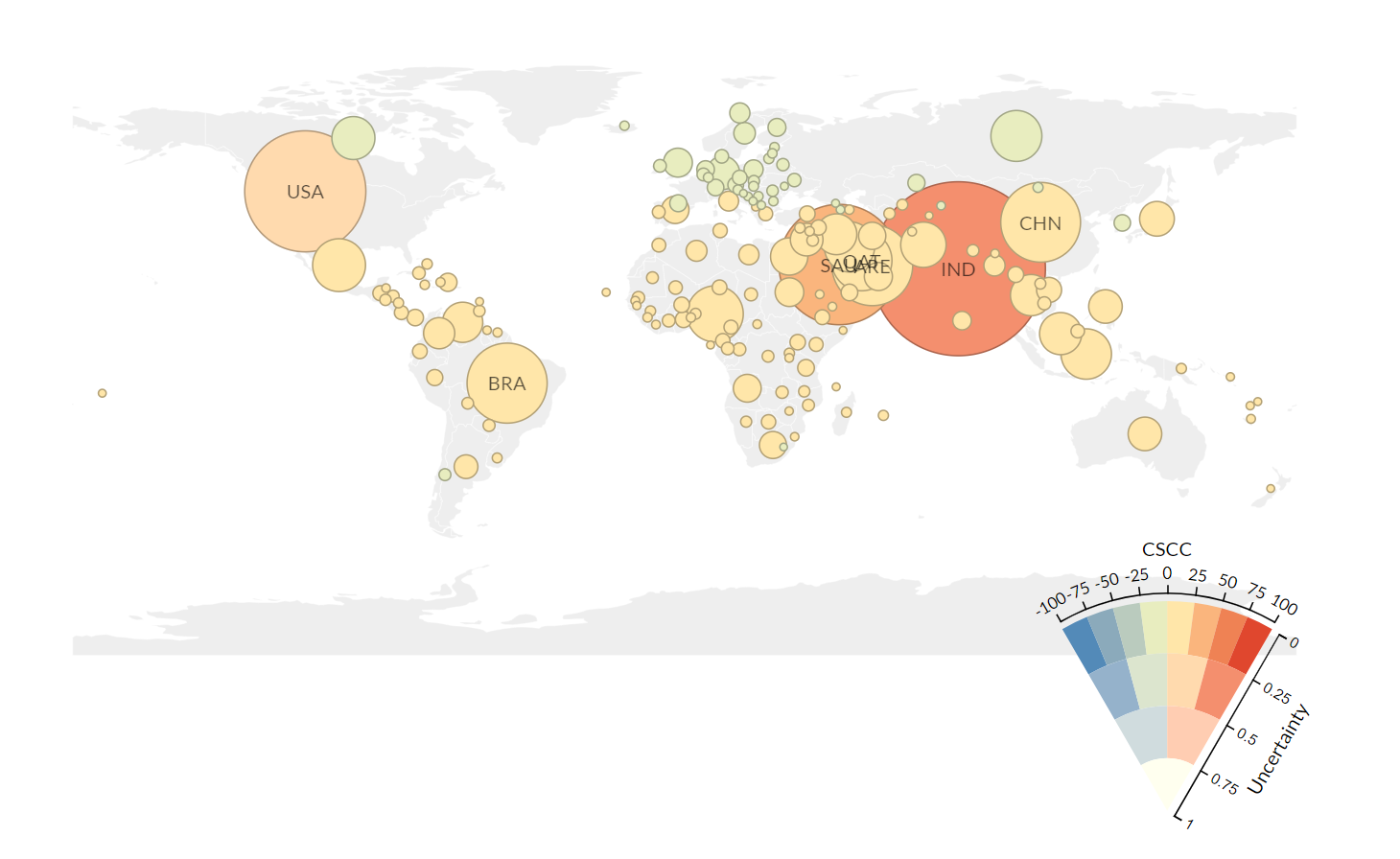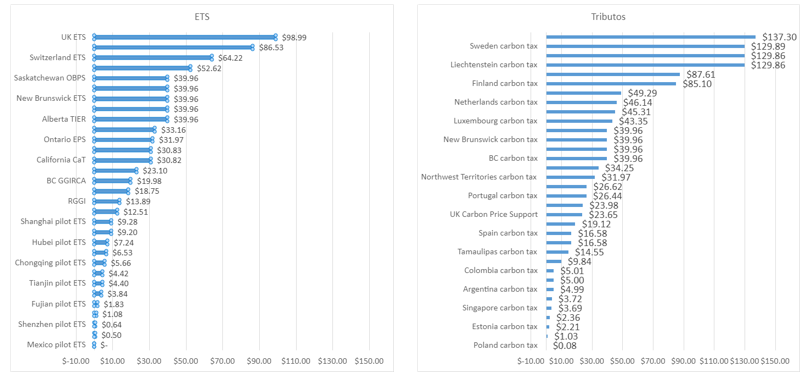What is the social cost of carbon?
Environmental and climate sustainability issues are receiving increasing attention from the public, governments, and businesses. Among these issues, the reduction of greenhouse gas (GHG) emissions is receiving particular attention due to the widespread impacts that global warming can cause.
However, the benefits of reducing global warming may seem distant and somewhat vague to some economic actors, particularly because the costs of global warming are spread throughout society, while the false benefits of polluting (or the costs of not polluting) can be captured and understood more clearly by polluters. It is therefore necessary to “translate” the effects of global warming into monetary values, so that these costs can be made explicit to society.
What is the social cost of carbon?
The Social Cost of Carbon (SCC) is a way of assigning a monetary value to the impacts of global warming on society. It is a fundamental concept for understanding the economic and environmental challenges posed by climate change. It represents the social cost of an additional tonne of carbon dioxide emissions or its equivalent, such as damage to property, reduced productivity or household income. By estimating the SCC, decision-makers can assess the costs and benefits of different policies and measures to mitigate climate change.
For example, if the SCC is high, then the most efficient choice for society would be to invest in clean technologies, reduce GHG emissions, and thereby minimize the negative impacts of climate change. On the other hand, if the social cost of carbon is low, it may be more efficient to invest in climate change adaptation – such as making infrastructure more resilient to extreme events – rather than mitigating GHG emissions.
1 It is important to note, however, that as the stock of carbon in the atmosphere increases, so do the effects of global warming, particularly through positive feedback that increase the concentration of greenhouse gases in the atmosphere. Therefore, delaying the mitigation of global warming significantly increases the social cost of carbon. For a more detailed analysis of this issue, see Dietz and Venmans (2019).
Another use of the SCC is to serve as a reference for carbon pricing instruments. In an optimised policy that maximizes inter-temporal welfare, the price of carbon should be equal to its social cost, so that the marginal benefit of pollution is reduced, leading companies to invest in GHG emission reductions, as abatement options below the carbon price become economically more attractive (NORDHAUS, 2007).
Estimates for the social cost of carbon
Calculating the SCC requires quantifying the whole process of relating anthropogenic GHG emissions to social welfare impacts. Estimating this cost, however, is not straightforward due to the complexity of climate systems and the uncertainties associated with technological development, population income growth, economic interest rates, population preferences, and so on.
Currently, one of the main ways of estimating this cost is through Integrated Assessment Models, which simulate, among other things, the pathways of GHG concentration in the atmosphere, the impact of this GHG increase on global temperature, and the changes in production and consumption caused by the temperature increase. Due to uncertainties inherent to climate and economic variables, there are several Integrated Assessment Models that produce different estimates of the SCC. Also, due to the uncertainties associated with the estimates, the results of these models are best used for scenario analysis and should not be interpreted as predictions.
Figure 1 – Social Costs of Carbon per country (SSP2/RCP6.0 scenario)

Source: Ricke, Caldeira and Tavoni (2018)
Figure 1 illustrates the diversity of costs per country in a given scenario, according to the estimates of Ricke, Caldeira and Tavoni (2018). The authors estimate an average social cost of $418 for the world in the SSP2/RCP6.03 scenario, while for Brazil, this cost is $24.20 in the same scenario. Nordhaus (2007) also analyses the difference between the global social costs estimated by him and by Stern (2007) – the difference between the two estimates can reach more than 10 times depending on the time horizon (for 2015, Nordhaus estimated a cost of $35 while Stern estimated $360).
The SCC in international climate policy
Despite the different estimates associated with the SCC, this metric can be an important reference point for climate policy. At the international level, it could also be an anchor for harmonised international carbon prices as a mechanism to avoid free riding among countries with more permissive climate policies (NORDHAUS, 2019).
In this regard, the States and Trends of Carbon Markets report for 2022 by the World Bank highlights that there is growing interest in establishing common standards for carbon pricing across jurisdictions. The most ambitious of these approaches would be the adoption of an international carbon price floor, either globally or among major emitting countries, since this policy would be broader and more efficient than Border Adjustment Mechanisms. Although it does not mention what this minimum price would be, the report cites a range of prices advocated by some climate experts consulted by Reuters that varies from $50 to $250, with a median of $100. A study by the International Monetary Fund suggests a price range between $25 and $75 per tonne of CO2 (PARRY, BLACK, and ROAF, 2021).
Have Carbon Prices Followed the SCC?
However, it should be noted that a large proportion of the jurisdictions that pricing carbon do not even exceed the minimum range suggested by Parry, Back, and Roaf (2021). Additionally, not all emissions from these jurisdictions are covered by the pricing system, limiting the impact of the price on abatement – the World Bank estimates that around 23% of global emissions are currently covered by some form of carbon pricing, such as carbon taxes and emission trading systems (ETS).
Figure 2 – Carbon Prices in Different Jurisdictions

Source: Adapted from Carbon Pricing Dashboard (World Bank, 2023)
Conclusion
Despite limitations associated with the inherent uncertainty of estimation models for the social cost of carbon, this metric is extremely useful for defining an optimal climate policy, so that carbon pricing – or other climate policies – can be evaluated according to their cost-benefit ratio. It is interesting to note that carbon pricing is a tool recognized and accepted by many economists, even if there is disagreement on the range of values. However, the main dilemma is that pricing is subject to a free-rider or “I’ll do it if you do it”4 problem, so global agreements require coordination efforts to ensure that these tools are widely adopted. In this sense, the SCC is also a tool for anchoring global prices to avoid uneven pricing among countries.
References
World Bank. State and Trends of Carbon Pricing. 2022. Available at: https://openknowledge.worldbank.org/entities/publication/a1abead2-de91-5992-bb7a-73d8aaaf767f.
World Bank. Carbon Pricing Dashboard. 2023. Available at: https://carbonpricingdashboard.worldbank.org/,
DIETZ, Simon; VENMANS, Frank. Cumulative carbon emissions and economic policy: in search of general principles. Journal of Environmental Economics and Management, v. 96, pp. 108-129, 2019.
Intergovernmental Panel on Climate Change (IPCC). Definition of Terms Used Within the DDC Pages. Available at: <https://www.ipcc-data.org/guidelines/pages/definitions.html#:~:text=Forecast%2FPrediction&text=A%20forecast%20is%20often%20obtained,to%20be%20attached%20to%20projections.&text=A%20scenario%20is%20a%20coherent,future%20state%20of%20the%20world.>
Ricke; L. Drouet,; K. Caldeira and M. Tavoni, Country-level Social Cost of Carbon, Nature Climate Change. DOI: 10.1038/ s41558-018-0282-y.
NORDHAUS, W. Climate change: The ultimate challenge for economics. American Economic Review, v. 109, n. 6, pp. 1991–2014, 2019.
NORDHAUS, W. “A Review of the ‘Stern Review on the Economics of Climate Change.'” Journal of Economic Literature 45, no. 3 (2007): 686-702. http://www.jstor.org/stable/27646843.
Parry, Ian, Simon Black, and James Roaf. 2021. “Proposal for an International Carbon Price Floor among Large Emitters.” IMF Staff Climate Notes 2021/001, International Monetary Fund, Washingtonne, DC.
STERN, Nicholas. 2007. The Economics of Climate Change: The Stern Review. Cambridge and New York: Cambridge University Press.
TIROLE, Jean. Carbon Pricing for a Climate Coalition. Tolouse School of Economics. 2016.









